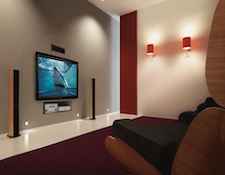It’s the time of year for saving money!
The first three parts of this continuing series were devoted to, among other things, saying that the traditional Hi-Fi buying advice published elsewhere (to allocate some particular percentage of your Hi-Fi budget to buying this part of your system; this much to this other; and these percentages to the rest) simply doesn’t apply except post facto. You can’t know how much you’re going to spend for your system until you’ve done some shopping to see what things cost, and you can’t know what to shop for until you’ve decided what you want your system to do for you.
 In line with this, I introduced the idea that there are (at least) two basic kinds of home audio systems – the ones that, like major appliances, their owners just buy and keep for as long as they continue to work (“keeper” systems), and those others, usually owned by an audiophile or a music lover, that will likely be changed over the course of time as their owner’s tastes and preferences, budget, and level of commitment change, and as new or different products come on the market to attract his buying attention.
In line with this, I introduced the idea that there are (at least) two basic kinds of home audio systems – the ones that, like major appliances, their owners just buy and keep for as long as they continue to work (“keeper” systems), and those others, usually owned by an audiophile or a music lover, that will likely be changed over the course of time as their owner’s tastes and preferences, budget, and level of commitment change, and as new or different products come on the market to attract his buying attention.
In those earlier articles, although parts of what I wrote could certainly apply to any system purchase at all, what I concentrated on was “keeper” systems; possibly for the office, the bedroom, or some other non-principal listening room, that would be used to provide background music or possibly the occasional news report, but not be used for serious or critical listening.
For systems intended not just to provide casual entertainment, but to get as close as possible to the real sound or spirit of the music (“High Intention” systems), getting good value – especially in these times of US$150,000 turntables and multi-hundred thousand dollar speaker systems – may seem a fool’s errand, but the fact of it is that there are some easy and basic things that you can do to get truly remarkable sound without needing to break the bank in the process.
 The first two are, again, as they were for “keeper” systems, matters of attitude and basic approach: To make sure that your system will always be as good as possible for the lowest possible long-term cost, you’ll need to 1) recognize that you system really is a system, and not just a collection of changing parts and 2), You’ll need to recognize and plan for the fact that it WILL be changing. vas
The first two are, again, as they were for “keeper” systems, matters of attitude and basic approach: To make sure that your system will always be as good as possible for the lowest possible long-term cost, you’ll need to 1) recognize that you system really is a system, and not just a collection of changing parts and 2), You’ll need to recognize and plan for the fact that it WILL be changing. vas
Let’s take a look at the “system” aspect first: The #1 definition of a “system” posted in Dictionary.Com is “an assemblage or combination of things or parts forming a complex or unitary whole”. That may seem obvious, and certainly we all recognize some of the “things” and “parts” that make up a High Intention audio system as being the various Hi-Fi sources, other electronics, and speakers that we will use in assembling it, but in reality, those are not all the system will consist of: There will also be the stands or furniture that the components are set on; the cables that will connect everything together, and the one essential component that is most often overlooked – the room that the system will play in.
To give you an idea of how important I think the room is, back when my daughter was still growing up, I remember saying to someone that if I had US$100,000 to spend for a Hi-Fi system, I’d probably spend US$10,000 for the speakers, US$ 20,000 for the rest of the equipment, US$20,000 for building or treatments or modifications to improve the acoustics of my listening room, and keep the remaining US$50,000 for her college education.
It’s that important! And, you can go a long way toward improving your room’s acoustics and the entire sound of your system with relatively very little money – or, in some cases, even free! You want proof? Consider this: How many times have you been to or read/heard about the often less-than-terrific sound at CES or other Hi-Fi shows? Why do you think that is? It’s certainly not because the speakers, the equipment, or the sound quality of the recordings being played aren’t good; What manufacturer in his right mind would pay thousands of dollars to exhibit or demonstrate stuff that’s not up to par? Instead, it’s the poor – and often untreated in any way – acoustics of the hotel rooms the exhibits are set-up in and the limited time available to get them set-up properly.
 That’s why it’s common knowledge that anything you hear at a Show will probably sound better in your own home listening room. And even such things as just rearranging your speakers (or your entire furniture/system arrangement) can make a big difference. So can adding plants or adding or changing carpeting – or even hanging one or more small (anything from 3′ X 5′ to 5′ X 8′) colorful and decorative rugs on your listening room walls at appropriate locations.
That’s why it’s common knowledge that anything you hear at a Show will probably sound better in your own home listening room. And even such things as just rearranging your speakers (or your entire furniture/system arrangement) can make a big difference. So can adding plants or adding or changing carpeting – or even hanging one or more small (anything from 3′ X 5′ to 5′ X 8′) colorful and decorative rugs on your listening room walls at appropriate locations.
I’ll go into the whole issue of system placement and affordable room treatment in other parts of this continuing series; For now, though, it’s sufficient to have established the importance of the room as part of your system and to get you to understand that – from a value standpoint – it’s entirely possible that a small amount of money spent on improving your listening room could very well have more of an effect on the sound of your system than spending many thousands of dollars on better equipment or speakers.
In addition to understanding that your system is a system, and that, like a chain, it can be no better than its weakest link, the most important thing to keep in mind as you go about putting together your High Intention system is that it WILL change over time. What that will do is to cause you to look at each new equipment or other purchase not only in terms of what new benefits it will bring, but also in terms of what other purchases or upgrades it will necessitate. Or, conversely, whether you’ll be able to keep it or need to replace it when you add or replace something else.
Getting both of these things right, even at the level of basic assumptions, will give you your best possible chance of getting your High Intention system right for the least possible amount of money and keeping it right for as little additional expenditure as possible as it inevitably changes over time.
We’ll talk more about this and other things next time.
I hope to see you then.








